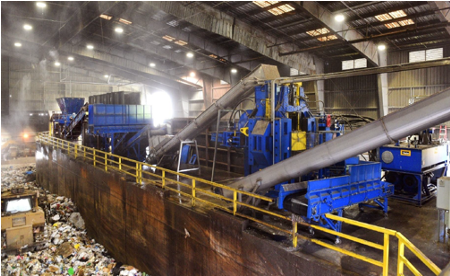
Converting Recology’s waste streams to bioenergy
Recology is an employee-owned resource recovery company headquartered in San Francisco.
Collecting and managing waste is tricky business. Recology knows that firsthand.
“Virtually everything we manage is a heterogeneous mass,” said Paul Yamamoto, Recology’s Director of Technology and Engineering. “Having the ability to manage the mass and add value to the material really opens up a lot of possibilities.”
Recology’s team first reached out to the ABPDU to begin a research project on evaluating the convertibility of their waste streams.
The project involved using a high pressure press to separate organic waste from landfill waste at Recology’s site. This organic waste was then sorted into food waste and paper waste streams.

Typically, municipal solid waste is characterized only chemically or physically. The collaboration between ABPDU and Recology allowed for an additional way of characterizing the waste — biological attributes. The project found that the food waste samples contained over 500 species of bacteria. The types of microorganisms found in the samples were similar, but their distribution and relative abundance varied. Although most species found were harmless and low-risk, some pathogenic species were identified.
Next, ABPDU ran an experiment to determine whether this waste could be converted into valuable intermediates. The ABPDU team was able to show that the organic waste streams are potential feedstock sources for biorefineries based on their abundance, carbohydrate composition and bio-conversion yield. The addition of selected enzyme cocktails to the homogenized substrates resulted in co-production of C6/C5 sugars and organic acids in the hydrolysates, which could be further converted to biofuels or bioproducts.
Recology’s Yamamoto said ABPDU’s ability to upgrade their waste streams into a bioenergy feedstock was beneficial for Recology, as this process is often costly and time consuming.
“The resources you lend are leading edge,” Yamamoto said. “It’s not something we could easily replicate internally.”
The two teams have continued their relationship, and often keep in touch to discuss potential funding opportunities.
This work has been submitted to a peer-reviewed journal.
“It’s been very enjoyable,” Yamamoto said. “Everyone that I’ve met at the ABPDU has been very friendly, positive, and proactive. That’s important to enable a continued collaboration.”